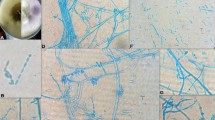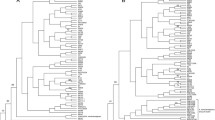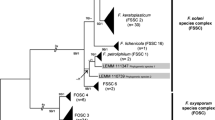Abstract
Inter- and intraspecific genomic variability of 18 isolates of Veronaea botryosa originating from clinical and environmental sources was studied using amplified fragment length polymorphism (AFLP). The species was originally described from the environment, but several severe cases of disseminated infection in apparently healthy individuals have been reported worldwide. All tested strains of V. botryosa, identified on the basis of sequencing and phenotypic and physiological criteria prior to our study, were confirmed by AFLP analysis, yielding a clear separation of V. botryosa as a rather homogeneous group from related species. In vitro antifungal susceptibility testing resulted in MIC90s across all strains in increasing order posaconazole (0.25 μg/ml), itraconazole (1 μg/ml), voriconazole (4 μg/ml), terbinafine (4 μg/ml), caspofungin (8 μg/ml), anidulafungin (8 μg/ml), isavuconazole (16 μg/ml), amphotericin B (16 μg/ml), and fluconazole (32 μg/ml). Overall, the isolates showed a uniform pattern of low MICs of itraconazole and posaconazole, but high MICs for remaining agents. The echinocandins (caspofungin and anidulafungin) had no activity against V. botryosa. There was no statistically significant difference between susceptibilities of environmental (n = 11) and clinical (n = 7) isolates of V. botryosa (P > 0.05).

Similar content being viewed by others
References
De Hoog GS, Guarro J, Gené J, Figueras MJ (eds). Atlas of Clinical Fungi, 2nd ed. Utrecht, The Netherlands and University Rovira i Virgili, Reus, Spain: Centraalbureau voor Schimmelcultures, 2000.
Ellis MB. More dematiaceous Hyphomycetes. Kew: Commonwealth Mycol Institute; 1976.
Badali H, Gueidan C, Najafzadeh MJ, Bonifaz A. Gerrits van den Ende AHG, de Hoog GS. Biodiversity of the genus Cladophialophora. Stud Mycol. 2008;61:175–91.
Arzanlou M, Groenewald JZ, Gams W, Braun U, Shin HD, Crous PW. Phylogenetic and morphotaxonomic revision of Ramichloridium and allied genera. Stud Mycol. 2007;58:57–93.
Chen YT, Lin HC, Huang CC, Lo YH. Cutaneous phaeohyphomycosis caused by an itraconazole and amphotericin B resistant strain of Veronaea botryosa. Int J Dermatol. 2006;45:429–32.
McGinnis MR. Chromoblastomycosis and phaeohyphomycosis: new concepts, diagnosis, and mycology. J Am Acad Dermatol. 1983;8:1–16.
Sutton DA, Rinaldi MG, Kielhofner M. First U.S. report of subcutaneous phaeohyphomycosis caused by Veronaea botryosa in a heart transplant recipient and review of the literature. J Clin Microbiol. 2004;42:2843–6.
Foulet V, Duvoux C, de Bièvre C, Hezode C, Bretagne S. Cutaneous phaeohyphomycosis caused by Veronaea botryosa in a liver transplant recipient successfully treated with itraconazole. Clin Infect Dis. 1999;29:689–90.
Matsushita A, Jilong L, Hiruma M, Kobayashi M, Matsumoto T, Ogawa H, Padhye AA. Subcutaneous phaeohyphomycosis caused by Veronaea botryosa in the People’s Republic of China. J Clin Microbiol. 2003;41:2219–22.
Badali H, Prenafeta-Boldu FX, Guarro J, Klaassen CH, Meis JF, de Hoog GS. Cladophialophora psammophila, a novel species of Chaetothyriales with a potential use in the bioremediation of volatile aromatic hydrocarbons. Fungal Biol. 2011;115:1019–129.
Hamzehei H, Yazdanparast S A, Khodavaisy S, Golekhili M, de Hoog GS, Badali H. Use of rolling circle amplification (RCA) to rapidly identify species of Cladophialophora potentially causing human infection. Mycopathologia 2013. doi:10.1007/s11046-013-9630-7
Vos P, Hogers R, Bleeker M, Reijans M, van de Lee T, Hornes M et al. AFLP: a new technique for DNA fingerprinting. Nucleic Acids Res. 1995;23:4407–14.
Badali H, Nabili M. Molecular tools in medical mycology; Where We Are! Jundishapur J Microbiol. 2013;6(1):1–3. doi:10.5812/jjm.8566.
Badali H, de Hoog GS, Curfs-Breuker I, Klaassen CH, Meis JF. Use of amplified fragment length polymorphism to identify 42 Cladophialophora strains related to cerebral phaeohyphomycosis with in vitro antifungal susceptibility. J Clin Microbiol. 2010;48:2350–6.
Bonifaz A, Davoudi MM, de Hoog GS, Padilla-Desgarennes C, Vázquez-González D, Navarrete G, Meis J F, Badali H. Severe disseminated phaeohyphomycosis in an immunocompetent patient caused by Veronaea botryosa. Mycopathologia. doi:10.1007/s11046-013-9632-5
Sang H, Zheng XE, Kong QT, Zhou WQ, He W, Lv GX, Shen YN, Liu WD. A rare complication of ear piercing: a case of subcutaneous phaeohyphomycosis caused by Veronaea botryosa in China. Med Mycol. 2011;49:296–302.
Clinical and Laboratory Standards Institute. Reference method for broth dilution antifungal susceptibility testing of filamentous fungi, approved standard, 2nd ed, Document M38–A2. Wayne: Clinical and Laboratory Standards Institute; 2008.
de Hoog GS, Vicente VA, Najafzadeh MJ, Harrak MJ, Badali H, Seyedmousavi S. Waterborne Exophiala species causing disease in cold-blooded animals. Persoonia. 2011;27:46–72.
Vicente VA, Attili-Angelis D, Pie MR, Queiroz-Telles F, Cruz LM, Najafzadeh MJ, et al. Environmental isolation of black yeast-like fungi involved in human infection. Stud Mycol. 2008;61:137–44.
Zhao J, Zeng J, de Hoog GS, Attili-Angelis D, Prenafeta-Boldú FX. Isolation of black yeasts by enrichment on atmospheres of monoaromatic hydrocarbons. Microbial Ecol. 2010;60:149–56.
Prenafeta-Boldú FX, Summerbell RC, de Hoog GS. Fungi growing on aromatic hydrocarbons: biotechnology’s unexpected encounter with biohazard. FEMS Microbiol Rev. 2006;30:109–30.
Revankar SG. Phaeohyphomycosis. Infect Dis Clin North Am. 2006;20:609–20.
Revankar SG, Sutton DA. Melanized fungi in human disease. Clin Microbiol Rev. 2010;23:884–928.
Chandrasekar P. Management of invasive fungal infections: a role for polyenes. J Antimicrob Chemother. 2011;66:457–65.
Badali H, Chander J, Bansal S, Aher A, Surendra SB, Meis JF, de Hoog GS. First autochthonous case of Rhinocladiella mackenziei cerebral abscess outside the Middle East. J Clin Microbiol. 2010;48:646–9.
Kondo Y, Hiruma M, Matsushita A, Matsuba S, Nishimura K, Takamori K. Cutaneous phaeohyphomycosis caused by Veronaea botryosa observed as sclerotic cells in tissue. Int J Dermatol. 2007;46:625–7.
Najafzadeh MJ, Rezusta A, Cameo MI, Zubiri ML, Yus MC, Badali H, et al. Successful treatment of chromoblastomycosis of 36 years duration caused by Fonsecaea monophora. Med Mycol. 2010;48:390–3.
Badali H, Najafzadeh MJ, Van Esbroeck M, Van den Enden E, Tarazooie B, Meis JF, de Hoog GS. The clinical spectrum of Exophiala jeanselmei, with a case report and in vitro antifungal susceptibility of the species. Med Mycol. 2010;48:318–27.
Montenegro MR, Miyaji M, Franco M, Nishimura K, Coelho KI, Horie Y, et al. Isolation of fungi from nature in the region of Botucata, State of São Paulo, Brazil, an endemic area of paracoccidioidomycosis. Mem Inst Oswaldo Cruz. 1996;91:665–70.
Zhang HE, Wang DL, Li RY. Report of a case of phaeohyphomycosis caused by Veronaea botryosa. Chin J Dermatol. 1990;23:96–8.
Wang DL, Li RY, Wang XH, Zhang HE. Studies on Veronaea botryosa agent of the first human case. Acta Mycol Sin. 1991;10:159–65.
Ayadi A, Huerre MR, de Bievre C. Phaeohyphomycosis caused by Veronaea botryosa. Lancet. 1995;346:1703–4.
Medina AL, Redondo JAD, Nebrida LM. Two unusual cases of mycoses in the Philippines. In: Proceedings of the 4th China–Japan International Congress on Mycology. 1998; 88.
Chen CC, Tsai YJ, Hu SL. Cutaneous Veronaea botryosa phaeohyphomycosis manifested as lymphocutaneous syndrome. Dermatol Sin. 2003;2(1):375–83.
Acknowledgments
H. Badali and S. A. Yazdanparast were financially supported by the Mazandaran University of Medical Sciences, Sari, Iran, and the Tehran University of Medical Sciences, Tehran, Iran, respectively, which we gratefully acknowledge. This study was partly funded by an educational grant from Basilea Pharmaceutica International AG, Basel, Switzerland.
Conflict of interest
J.F.M. received grants form Astellas, Merck, Basilea, and Schering-Plough. He has been a consultant to Basilea and Merck and received speaker’s fees from Merck, Pfizer, Schering-Plough, Gilead, and Janssen Pharmaceutica. All other authors: no potential conflict of interest. The authors alone are responsible for the content and writing of the paper.
Author information
Authors and Affiliations
Corresponding author
Rights and permissions
About this article
Cite this article
Badali, H., Yazdanparast, S.A., Bonifaz, A. et al. Veronaea botryosa: Molecular Identification with Amplified Fragment Length Polymorphism (AFLP) and In vitro Antifungal Susceptibility. Mycopathologia 175, 505–513 (2013). https://doi.org/10.1007/s11046-013-9631-6
Received:
Accepted:
Published:
Issue Date:
DOI: https://doi.org/10.1007/s11046-013-9631-6




